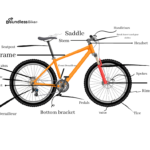Are you tired of uncomfortable bike rides? Do you want to ensure maximum comfort during your cycling adventures? Look no further! Installing a bike saddle may seem like a daunting task, but with our easy-to-follow guide, it’s a breeze. Say goodbye to sore bottoms and hello to enjoyable rides with our step-by-step instructions on how to install a bike saddle. Don’t let discomfort hold you back from reaching your full potential on two wheels – let’s get started!
How to Install Bike Saddle?
Installing a bike saddle is a relatively simple process that can greatly improve your comfort and performance while cycling. Here are the steps to follow when installing a bike saddle:
Gather Required Tools: To install a bike saddle, you will need a wrench, an Allen key set, and possibly a seat post clamp.
Remove the Old Saddle: Loosen the bolts or screws that attach the old saddle to the seat post using the wrench or Allen key set. Remove the saddle and set it aside.
Adjust the Seat Post Height: Before installing the new saddle, adjust the seat post height if necessary. Use the Allen key set to loosen the bolt or screw that secures the seat post in place. Raise or lower the seat post to your desired height, then tighten the bolt or screw to secure it.
Prepare the New Saddle: Check the manufacturer’s instructions for any specific preparation steps for your new saddle. Some saddles may require you to attach rails or other components before installation.
Install the New Saddle: Place the new saddle onto the seat post and align it with the seat post clamp. Tighten the bolts or screws to secure the saddle in place. Be careful not to over-tighten the bolts or screws, as this can damage the saddle or seat post.
Adjust the Saddle Angle: Use the Allen key set to adjust the angle of the saddle. The angle should be comfortable for your riding position and provide optimal support. A level or protractor can help ensure that the saddle is level.
Test the Saddle Position: Sit on the bike and check that the saddle is in the correct position for your comfort and performance. The saddle should support your sit bones without putting pressure on your soft tissues. Adjust the saddle position if necessary.
Tighten All Bolts: Once you have found the optimal saddle position, tighten all bolts and screws to the manufacturer’s recommended torque settings. Double-check that the saddle is secure.
Final Check and Test Ride: Conduct a final check of the saddle and take a test ride to ensure that it is comfortable and provides the support you need. Make any adjustments as necessary before riding for an extended period of time.
Note: If you are unsure about any part of the installation process, or if you encounter any issues, it is always recommended to consult with a professional bike mechanic. A properly installed saddle is essential for safe and comfortable riding, so it is important to ensure that the installation is done correctly.
Choosing the right saddle for your bike

When it comes to saddles, there is no one-size-fits-all solution. The most important factor in choosing the right saddle for your bike is comfort. There are a few things you should keep in mind when selecting a saddle, including the width of the seat, the amount of padding, and the shape of the nose.
Width: Most bike saddles range in width from 130mm to 145mm. If you are between sizes, it is better to choose the wider option. A too-narrow saddle can cause discomfort and even pain in your sit bones.
Padding: Padding helps absorb shocks and reduce vibration. Too much padding, however, can make a saddle feel mushy and can actually increase pressure on your sit bones. A good rule of thumb is to choose a saddle with just enough padding to make it comfortable without being too soft.
Shape: The shape of the nose of the saddle is also important for comfort. A pointed nose can put pressure on sensitive areas and cause discomfort. A flat or slightly rounded nose is usually more comfortable.
Tips for maintaining your bike saddle
If you’ve ever ridden a bike for more than five minutes, you know how important a comfortable saddle is. But what’s the best way to keep your bike seat in good condition? Here are a few tips:
– Avoid sitting on wet or dirty saddles. Not only is it more comfortable to ride on a clean saddle, but it also helps extend the life of the saddle.
– If you’re going to be riding in wet conditions, consider using a rain cover or Saddle Shield to protect your saddle from the elements.
– When not in use, store your saddle in a cool, dry place out of direct sunlight. Heat and sunlight can cause the materials in your saddle to break down prematurely.
– Inspect your saddle regularly for any signs of wear and tear, and replace it as needed. A well-maintained saddle will last for years, but eventually, all saddles need to be replaced.
Pros and cons of installing bike saddle
Assuming you are talking about a new bike saddle, there are a few pros and cons to installing one.
Pros:
-A new bike saddle can provide more comfort than an old, worn-out saddle.
-A new saddle can also offer better support, which can help prevent pain in the back, neck, and shoulders.
-Installing a new bike saddle is a relatively easy and inexpensive way to improve your cycling experience.
Cons:
-If you don’t take the time to find a good quality saddle that fits your body type and riding style, you may end up being just as uncomfortable
– or even more uncomfortable – than you were before.
-Bike saddles can be one of the most personal pieces of equipment on your bike, so it can take some trial and error to find the perfect one for you.
Faq
You will need a wrench, an Allen key set, and possibly a seat post clamp.
Use the Allen key set to loosen the bolt or screw that secures the seat post in place. Raise or lower the seat post to your desired height, then tighten the bolt or screw to secure it.
Sit on the bike and check that the saddle is in the correct position for your comfort and performance. The saddle should support your sit bones without putting pressure on your soft tissues.
Use the Allen key set to adjust the angle of the saddle. The angle should be comfortable for your riding position and provide optimal support.
Conclusion
In conclusion, installing a bike saddle is a fairly simple process that can greatly improve your riding experience. By following these steps, you can ensure that your saddle is installed correctly and provides the necessary support and comfort for your rides.






